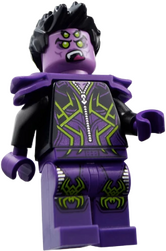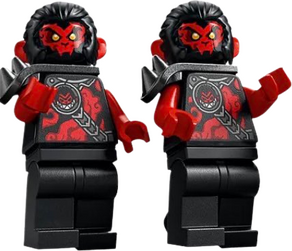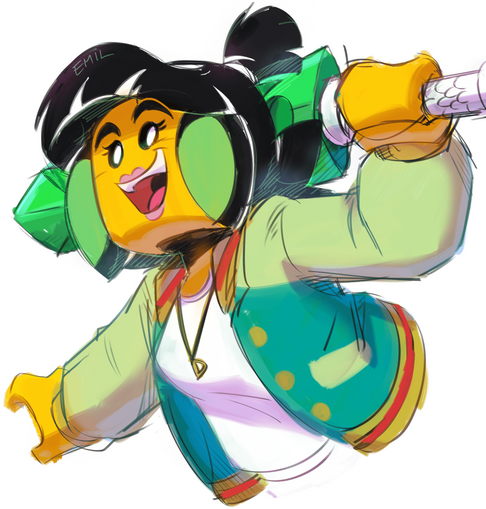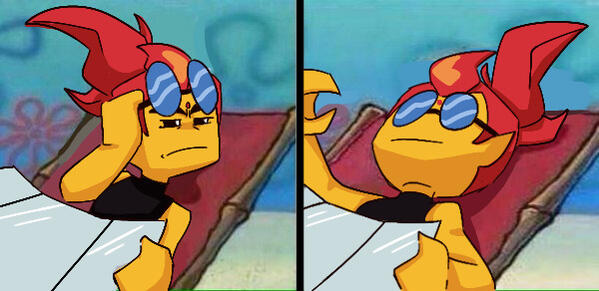
Hey everyone! Today I have the privilege of being able to sit down with Villads Spangsberg, former showrunner on LEGO Monkie Kid and current showrunner on Netflix’s The Dragon Prince. We'll be discussing his work and experiences during his time on LEGO Monkie Kid as well as fan-favorite characters and dynamics on the show.LEGO Monkie Kid is an animated spin-off of the classic Chinese novel Journey to the West that revisits classic tales from the novel, but with a modern twist. The show follows the protagonist MK in his journey to fulfill his destiny as the chosen successor of the Monkey King upon his retirement, as well as his responsibility to save the city from the demons and monsters that try to harm it.I am beyond grateful to Villads for taking the time out of his schedule to allow me to interview him about this show that I love so dearly. LEGO Monkie Kid is a profoundly unique show in both its breathtaking visuals and captivating storytelling, leaving plenty of room for further exploration of its events, characters, and production. Villads and I are going to delve into these topics that I and many other fans have been dying to know more about! Let’s get started.[This interview has been mildly edited and condensed for clarity.]
Candy: So, before we get into the actual interview, let’s discuss your position on Monkie Kid! The term ‘showrunner’ seems self-explanatory in hindsight, but some readers may not be informed on the specifics of what a showrunner is responsible for. Could you explain what being the showrunner of Monkie Kid entails?Villads: So, Monkie Kid is a LEGO property, and I was hired to work at LEGO to produce the show together with the entertainment, marketing, and design teams. Being the showrunner means you’re basically the head creative in charge of writing, animation, and the end product from soup to nuts. You ensure that we get the right animation studio, the right directors, the right writers, etc.
Since we work with a Sydney-based studio, and LEGO is in Denmark, and the writers are in LA, you wake up quite early to have meetings with the director and the animators. You take a break, then you have a meeting with some of your LEGO colleagues in Denmark about how to integrate the newest products into the writing in an organic way. Then when you figure that out, you call Los Angeles, which would be later in the afternoon or early evening in Denmark, and you explain to them, “Hey, we have all these cool products that we want to feature, and here’s how we think we’re gonna do it.”You’re in charge of making sure that you also pick and choose the right battles, ‘cause you know the amount of time that’s allowed before the show comes out. You have your budgets and the limits that you have to work within, and it doesn’t matter if you have a big budget or small budget, because you have to make something of quality that’s worth watching with the means available. That’s the real challenge of a showrunner.
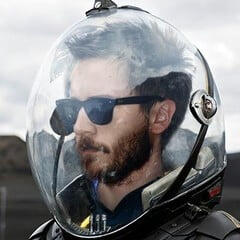
Villads Spangsberg, former showrunner on Monkie Kid
Candy: One of the most notable aspects of Monkie Kid’s storytelling formula is that it doesn’t stick to episodic or serialized storytelling alone, but rather utilizes both of these methods, sometimes even combining both. Did you guys face any challenges with balancing episodic and serialized storytelling?Villads: So, the initial pitch for the show was a one-off, “See how it does, and continue if it does really well." And to make sure that we had something that was, in terms of distribution, very agile, we went episodic. That way, you can show two episodes, then next time you can show the same two episodes together with another one, mix and match. We wanted to do it like this to begin with so more broadcasters would potentially be interested in buying the TV show. Episodic children's animation is traditionally easier to sell than heavily serialized.
It’s also a little bit easier to digest when you’re first getting used to the show and the characters. You know, you can do, like, Mei’s episode about her backstory, then you can do Sandy’s episode, and so on. It frees up screen time to just dive into the characters instead of having to spend time on explaining the larger plot. But then, of course, as we went into season 2, gloves were off; we could do whatever we wanted, and I pushed pretty hard to have more of an overarching arc and for it to be a trilogy of three seasons. We did not have season 3 greenlit in any way or sort; we didn’t have any money to do a season 3 when we were writing season 2, but we pushed pretty hard for a fairly big cliffhanger at the end of season 2. Then season 3 went fully serialized.It’s kind of a slippery slope into the universe with the episodic season 1, then you get more and more hooked, and then we also turn up the stakes and the emotions. So yeah, I think it was a good strategy.
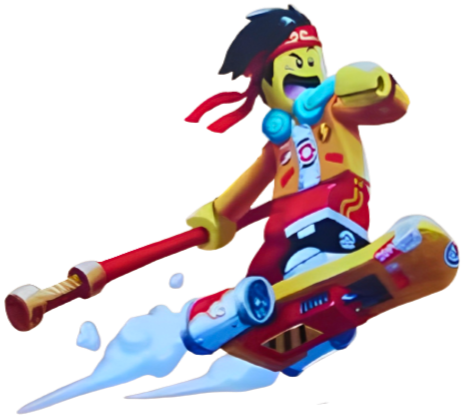
Concept art of MK by Xiaodong Wen, senior designer at LEGO
Candy: With a novel like Journey to the West which spans over 1500 pages, it must be incredibly difficult to choose which characters to adapt into Monkie Kid! With the show’s limited runtime, I’d imagine you have to choose wisely, because you can’t possibly fit all of them in. Can you shed some light on the creative process behind choosing specific Journey to the West characters and modernizing them to fit the vision of Monkie Kid?Villads: Simon Lucas and Xiaodong, who are both producers on the show and also two of the very talented creators of the toy IP, had a pretty big say in what the right approach would be and what would be best for our target audience, especially in China. ‘Cause there’s a lot of parents that just wanna tell Journey to the West to their kids, but it’s been done so many times, and we also felt that we weren’t necessarily the right people to tell that story. The source material is loved by so many, and you have to be extremely respectful and careful when trying to interpret those great mythologies.Everyone in China has a very strong opinion about Journey to the West, so to allow a bit more freedom, it was decided early on to make it not Monkey King, but Monkie Kid. And by doing that, we also decided to put our own spin on most of the stories and characters. So, of course, Sandy, Pigsy, and all of them are based on characters from the original book(s), but we gave them a bit of a twist. We always wanted to give it all a little bit of a unique LEGO feel, and that would allow us more freedom too.Sarah and David, two of the incredible directors in Sydney, are both really into the source material and the many iterations of Sun Wukong. So they would have their version of what Monkey King should be like, then Xiaodong would have his version, and then the awesome marketing team in China would have their version. And surprise, they’re all quite different. It’s like, you have some people that think that Monkey King’s like a saint that could do no wrong. Like literally, they would not agree that he would do anything wrong. I’ll be like, “Well, he kinda stole those things.” “No, no, no, no, no, he didn’t steal them. He was handed them.” And as we had those kinds of fun conversations, I pretty quickly realized that to avoid too many complications, we had to free ourselves a little bit by saying, “Well, this is a new LEGO universe inspired by Journey to the West, and the characters are not one-to-one.” So by doing that, we also picked the characters that were coolest and made the most sense to scale down into minifigures, made the best playing opportunities, and made the best products. Some of the characters are great characters with great stories, but they just don’t make great toys, so we pick and choose them.Also, at LEGO, we test everything with a kid audience. Not so much the TV show, but we go off of what could be beautiful concept drawings and maybe some preliminary LEGO products, and we show it to a bunch of kids. Then we get a study of what they like. For example, they could really be into Mei’s motorcycle and Sandy’s plane, which then affects what kind of characters and stories we would be bringing to the screen.
͏͏͏͏͏͏ ͏͏͏͏͏͏ ͏͏͏͏͏͏ ͏͏͏͏͏͏ ͏͏͏͏͏͏ ͏͏͏͏͏͏ ͏͏͏͏͏͏ ͏͏͏͏͏͏ ͏͏͏͏͏͏ ͏͏͏͏͏͏
͏͏͏͏͏͏ ͏͏͏͏͏͏ ͏͏͏͏͏͏ ͏͏͏͏͏͏ ͏͏͏͏͏͏ ͏͏͏͏͏͏ ͏͏͏͏͏͏ ͏͏͏͏͏͏ ͏͏͏͏͏͏ ͏͏͏͏͏͏
Candy: It’s no secret that Sun Wukong’s popularity has sparked dozens of unique iterations of his character in various media, including Monkie Kid. Can you share which Sun Wukong and/or Journey to the West media/iterations may have influenced Monkie Kid’s Sun Wukong that we all know and love?Villads: I feel like it’s a little bit of all of them. I myself didn’t write it; we had many writers, directors, and creators involved, Simon Lucas as well, and all the people at toy production were also heavily involved in choosing and telling the stories. So I would say it’s a mix of a lot of different sources of literature and references.
⬅️ Illustration of LEGO Sun Wukong by fan-artist
͏͏͏͏͏͏ ͏͏͏͏͏͏ ͏͏͏͏͏͏ ͏͏͏͏͏͏ ͏͏͏͏͏͏ ͏͏͏͏͏͏ ͏͏͏͏͏͏ ͏͏͏͏͏͏@SwagginMun on Twitter
Candy: One of the most highly acclaimed aspects of Monkie Kid is just how visually beautiful it is, from the scenery, to the animation, to the vibrant colors, you name it! Could you share some of the different media and art styles that inspired Monkie Kid’s art style?Villads: Yeah! It’s very much Flying Bark in Sydney. That animation studio ended up doing the best test for the show. We asked several studios to do a test, and Flying Bark just has this incredible hand-drawn, like, in-house style that’s kind of just become their thing, and they do it really, really well.A lot of animation right now is also very anime-inspired. Generally, it doesn’t matter where you do the animation, everyone wants to do anime-inspired shows. Flying Bark brought a combination of anime and Western sensibilities to the animation style. I brought my more classic storytelling and Spielbergian kind of way of setting up shots, making sure that we bring the audience along in each scene. ‘Cause sometimes, real intense anime can be a little bit disorientating; it’s a lot of cool effects, animation, and crazy action, but you have no idea what’s actually going on. If you’re really into it, that’s great, but a lot of people will just kind of zone out and be like, yeah, whatever. It looks great, but they don’t care about the scene as they don’t really know the stakes because the action is just insane. So it was just about finding balance, really.
Candy: Though its target audience is children, Monkie Kid has proven to get quite risky when it comes to the contents of its storytelling, teetering on the line of being too frightening for younger kids. Have there ever been any ideas or scenes that were forcibly cut for this reason?Villads: Sure, but it’s been done pretty early on in rough storyboards. There have been a few times, but honestly, the director and the board team all have been really good about finding the right level and pushing what’s worth pushing. But yeah, I think it’s about striking a balance where you don’t wanna talk down to the kids. You don’t wanna make it like a pre-school show. In terms of complexity, kids can take a lot. But in terms of being scary, we might have been pushing some limits there.
I wanted to go pretty hard on the horror with Lady Bone Demon. The classic ‘sounds young and innocent but is actually the scariest person in the universe.’ So that worked out great, and I wanted to push for that. The stuff that we did cut was more like, I don’t have a good example, but I’ve seen on other shows where they have somebody getting stabbed with a knife. That’s really inappropriate for a kids show, because you can actually go out, pick up a knife, and do that to your friend. Whereas a magical bone demon rising up from a grave, kids can go and play that out; that’s totally fine, that’s not gonna hurt anybody but your mother's veggie garden. It’s more like, you know, “Don’t blow up a balloon,” because balloons kill more kids than any other toy. You tend to learn the trades of the industry pretty quickly when you work in kids’ animation.Actually, I’ll give you one example that did not get cut, but I had to fight for it to stay in. I believe it was S&P (Standards and Practices) who told us that we could not have Pigsy in the shopping cart. There’s an episode where Pigsy is asleep in the shopping cart while MK is pushing it around, and kids are not allowed to be in shopping carts because that’s dangerous, since shopping carts can tip over. So normally, you wouldn’t show anybody riding in a shopping cart, but I had to argue like, “First of all, he’s a pig. And he’s an adult. Can we please keep it?”
Candy: I think it’s safe to say that it’s practically unavoidable in the television business for plenty of awesome ideas and content to get cut from the final product due to time constraints or other obstacles during show production. Have there ever been any other interesting ideas/scenes scrapped during development that you were upset didn’t make it into the show?Villads: Well, that’s the good thing about being the showrunner, haha. Ultimately, I decide what makes it in. So, most of my ideas made it in, and I’m not too sad about anything that got cut.I’ve told this story before, but originally when I came onto the show, they were doing the pilot episode’s first 5-10 minute animatic, and there were a lot of people pushing to have it basically be Journey to the West retold. And it was kind of like, this feels like an Animal Planet or Discovery Channel documentary, and I was like, “Oh man, no kids are gonna watch this.” I’m sure a lot of parents would be really excited to watch it, but I don’t think that kids would as much. So we changed that, but I’m not sad we cut it. That was a bit of a fight to begin with, because if you show that it’s Journey to the West, chances are you will be an instant success in China. But I was like, “Yeahhh, but we need to be a little bit more than that; we need people to be engaged in the show and watch more than the first 10 minutes." And again, like I said before, I don’t think we were the right people to tell that great story 1:1. Right away, we had to have some respect for the source material, and we had to learn before going deeper into it.
Candy: Sun Wukong and Macaque’s history is without a doubt one of the most beloved subplots in Monkie Kid for its brilliant execution and complexity. When we, the audience, first see these two characters interact, we all collectively assume that Macaque was the cause of their conflict; like, he’s the villain, of course he is. But as we learn more about their past from Macaque’s side of the story, we learn that there’s so much more that cultivates his actions and emotions. Things start becoming more and more contradictory, and we’re left wondering who is really the bad guy in this situation. The most logical conclusion one can draw is that their conflict was built entirely on misunderstandings from both sides, but in the end, it wasn’t exactly confirmed if that was the case, or if one side was truly at fault for their conflict. Would you say that their story was left open-ended for the audience to draw their own conclusions, or was it left open-ended with the intention for more story to be told in the future?Villads: Well, I can tell you that we instantly knew Macaque was gonna be a fan-favorite. He just worked right away. He was easy to write for, and also Monkey King; I loved writing for Monkey King because he was like the broken mentor. We were trying to push him down that kind of path. Meanwhile, Macaque comes in with full confidence, and he seems like he can fill that void of the broken mentor. But Macaque was the evil mentor.
Then, because they kind of mirror each other, diving into that relationship is just really great. It’s great to write for, and especially Billy, Macaque's voice actor, just brought that character to life in a way not a lot of us have seen before. I think that David Breen also had a bit of a vision for how to put those two characters up against each other, and he also had a heavy hand in the "Shadowplay" episode, where I think, in terms of complexity I mentioned earlier, we definitely pushed the limits. LEGO had no idea what was going on in those episodes, but they wouldn’t say it, because they didn’t wanna be like- they didn’t wanna sound like that. But those episodes were really intense and showed the many layers of Macaque’s character.So yeah, that’s a good question. I think in our show, there’s a lot of misunderstandings, and you know, they clearly start out as enemies, but there’s an arc to that relationship. I don’t know where they’re taking it in season 4, so that’s gonna be interesting to see.
Candy: Speaking of "Shadowplay," there’s a very specific detail in that episode that very few people caught on their first time watching, but it left some very observant fans shocked and confused. Macaque is shown to directly block an attack from MK’s staff, which should be impossible; it’s been established multiple times that nobody should be able to hold the staff except for MK and Wukong, or someone else with Wukong’s powers. Is it possible that Macaque still has remnants of Wukong’s powers from the time he stole them in season 1, or is there a different explanation for this instance?Villads: I’m gonna have to think back, because it’s been a really long time since I watched that episode. My oldest wasn’t even born when we wrote that episode.As you said, he should not have been able to do that. But, again, if it serves the story of the episode, sometimes you have to bend the larger logic that we don’t necessarily mention or stick to in this show 100%. And again, there’s so many iterations of that damn staff, so we had to find our own version of it. And I believe because Macaque stole and absorbed MK’s powers, that must be the reason why he can block it, but I’m actually not 100% sure because I can’t remember. Also like, he’s a trickster, maybe it’s a trick! Maybe MK is actually not striking him, who knows! I can’t remember exactly, but I’m sure that if we really went into it, there’s probably a good logical explanation. Ask David and Sarah, ahah!
Candy: Fans of the animated series Monkey King ‘09 have noticed that many aspects of Sun Wukong and Macaque’s relationship in Monkie Kid are similar to Sun Wukong and Liu Er’s relationship in ‘09. By any chance, is it true that inspiration was taken from ‘09 to write the story between Wukong and Macaque in Monkie Kid?Villads: I don’t know. That’s a good question. Not to my knowledge. Again, Sarah and David, the directors in Sydney, had a lot of ideas and knowledge of popular TV shows, especially anime, and they definitely brought a lot of inspiration, references, and homages to the table. So I wouldn’t know, to be honest.I usually look at it like its own thing. I really try not to rely on any source material if I can avoid it. Like, when we first pitched the show, there had to be a really original idea for the show that wasn’t based on anything else, unless it’s an adaptation, of course. But this was not an adaptation. When I get the script, I always just look at what’s in those 11 minutes of animated content. That’s what I care about. I don’t really care about how it’s inspired, or where it comes from, or anything. If I like what I’m seeing, that’s the most important part. If there’s a gimmick or homage that doesn’t quite work, but it serves the overall show and the story, then it’ll probably be fine. Sometimes it can cause some fights between the directors and animators, ‘cause they’ll want to reference, let’s say, a Star Wars thing or whatever, but if it doesn’t serve the story or the episode, then, well, we probably shouldn’t do it. Animators slip in little things by themselves all the time though, and that’s totally fine. I love that.
Candy: The season 3 episode “Benched” brought about a very interesting interaction between Tang and Macaque, especially considering they’d never even spoken to each other before. Can you shed some light on the thought process behind the unexpected decision to bring Tang into the picture for such a pivotal turning point in Macaque’s character development?
Villads: Well, we always loved Tang, and we always wanted to have him play a bigger part in the story. If you’ve seen the season 1 toys, Tang wasn’t even included. So it’s a hard sell to try and boost that character when he’s not actually a toy, but then because everybody loved Tang when they watched the TV show, he became a toy later. That then allowed us to dive into Tang’s role on the show, and yeah, it was just his time to shine!I think a lot of us can relate to Tang, because he’s the ‘benchwarmer.’ He never gets to do anything exciting, but he’s just as capable as everyone else when he gets the chance. When he’s thrown into the deep, he’s gonna swim! So yeah, it was a little bit of a no-brainer; it was about time to do it.
Candy: Good thing that you did, because Tang and Macaque’s dynamic is a very interesting concept. Macaque is the embodiment of darkness and anger, while Tang embodies the exact opposite. Tang uses love as strength, while Macaque has faced betrayal too many times to ever believe in love again. These clashing personalities and mindsets formed a very compelling dynamic that had fans hooked, despite the limited interaction between the two, and many were sad that was the last we saw of them for the time being. Was that scene written with the intention of further fleshing out their dynamic for the future, or was that intended to be the first and last interaction we would see from them?Villads: That’s a great question and also a really great observation. ‘Cause, there’s a lot of love in Tang, that’s for sure. Especially towards MK, and the others- AND PIGSY. So, your question is were we planning on having more Tang and Macaque interactions in the future. I would say yeah, I think, because Tang becomes a stronger character, a stronger ally, and a stronger mentor.But also, the reason why it’s also funny is because Tang adores Monkey King like nobody else, and Macaque is in many ways the same as Monkey King. So for Tang to just completely hate Macaque is kind of funny, and he can really adore him as well. So, yeah, I don’t know. I think there’s room to make that happen. And again, Sarah and David, for season 4, they would probably love to do that. Question is just, again, screentime, if that’s where you wanna spend it.
Candy: In the season 2 episode “To Catch a Leaf,” Sandy is shown to have a very similar dynamic and interaction with Huntsman. Like Tang and Macaque, their ideals and personalities clash, but against all odds, they’re brought together for a pivotal turning point in Huntsman’s development. Towards the end of the episode, Huntsman is shown holding a tea packet with a solemn expression on his face, subtly implying that Sandy may have inspired him to possibly turn over a new leaf. Unfortunately, this was never confirmed, as Huntsman… died like two episodes later. Was it ever discussed or planned to bring these two together again for some closure before Huntsman kicked the bucket?Villads: No, I think that was the closure. Sandy did everything he could, and well, it’s a little bit hard to redeem evil characters. Even if he’s just a henchman, he’s still done all that bad stuff, so he’s hard to redeem! But uh, maybe he found some peace before he got killed off. There had to be some sort of judgment in this universe, hahah.
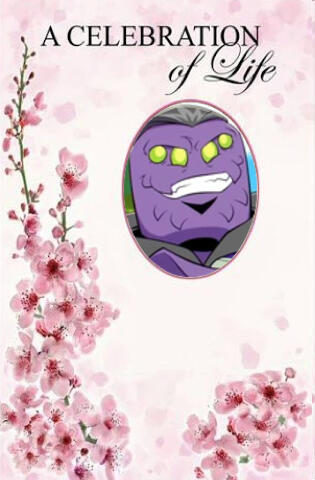
Candy: Red Son has been shown in the past to be an emotionally undisclosed character, often attempting to hide his true feelings, even going as far as to deny them (ex. “It’s not like I was dying to hang out with you guys or anything!”). But, it’s clear that Red Son sees Mei and MK as more than enemies; this isn’t subtly implying anything romantic either, just that Red Son obviously views Mei and MK in a positive light, no matter how much he tries to deny it. How would you say Red Son truly sees Mei and MK?
Villads: I think he’s been brought up as a lonely child with few friends; he’s kind of a little late to the game, but this is his first chance at having actual friends. It’s also very natural in the school playground that you start out as competitors or enemies, and you don’t realize that, hey, I actually kind of like hanging out with you guys. I don’t wanna admit it, but you are kind of fun.So I feel there’s always gonna be some rivalry between them, but deep down, I think they would have a great time hanging out on the couch and watching a movie together, that’s 100% sure. But he comes from a family of antagonists, so he has to keep some sort of balance. He’s the bad guy, and guess what: everybody loves him.
Candy: Similar to Red Son, Nezha is a very reserved person, but much less easy to read. He most often appears stoic or angry, especially when it comes to Sun Wukong. However, he seems to have taken a liking to Wukong’s successor, MK, which many fans have interpreted as a brotherly bond between the two. Can you share with us what feelings Nezha harbors towards MK?
Villads: I think he sees the potential of a worthy adversary. Nezha is a little bit more religious about his tasks and the powers that he’s been given, whereas Monkey King has been more of a trickster, so that’s where they’re very different. I think Nezha can see that MK has the same kind of respect for his powers, and there’s a lot of potential in MK. MK is, in theory, the very talented student who’s just a little bit of a, you know, he sleeps in and might not get all his homework done, but he can also come into class and just improvise and do what he wants. All the teachers secretly love those kinds of students, and so does Nezha for the same reason I think. At least, that’s how I was reading their developing relationship.
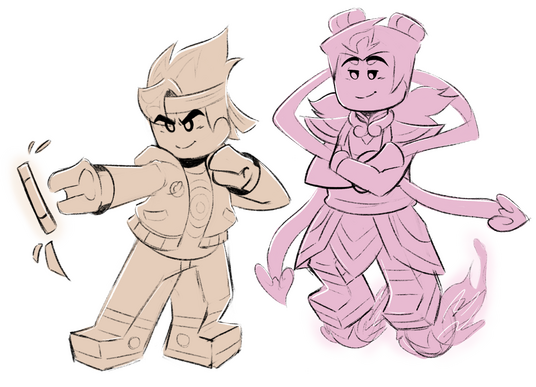
Illustration of MK and Nezha by fan-artist @colesmonkies on Twitter
Candy: It’s been established in the past that Monkie Kid’s LEGO sets are actually designed before writing takes place, and the show is based on the sets. Sometimes, though, ideas and designs from the sets aren’t included in the show for story structure purposes. This unfortunately includes minifigure characters that many fans were looking forward to seeing animated, namely Rumble, Savage, and Spindrax. Was there ever any discussion of potential personalities or storylines for these characters before they were eventually decided not to be included in the show?Villads: So, during the first year, because it was the first year for the IP, they did quite a lot of development for the products and characters before the TV show had started production. So when I came on, we had to take a look at all of that and figure out which parts would make a great TV show. And we had to make some tough decisions, because you just can’t fit everybody’s storylines in there. I particularly didn’t love the biker (Spindrax).
Also in animation, especially 2D, when you look at the silhouettes of the characters, you want somebody who’s not a minifigure if you can. So that’s why we went with the big, strong spider guy, who is just much more interesting visually, especially up against Sandy, rather than yet another minifigure biker.For Rumble and Savage, That’s probably more for Xiaodong and Simon Lucas to answer, ‘cause I’m not actually 100% sure. I think there’s always something; like, you’re an artist, so when you draw something, there’s always character right away in the first brush stroke.
Spindrax, Rumble, and Savage minifigures, pictured in order
Candy: Monkie Kid fans that have delved into the source material, Journey to the West, will know that one day in the celestial realm is equivalent to one year on earth. Some fans have theorized that the same rules apply to Monkie Kid, and that while Wukong was on his “vacation” in the celestial realm, months passed by for MK. Is that true?Villads: We definitely had that in mind when we were writing it. I think we had written in there that he’s been gone for a long, long time, but actually Monkey King has been really, really busy; he’s not been on vacation. So I believe we were somewhat true to that when we were writing it. ‘Cause that stuff is just always fun, it gives you a little bit more flexibility and freedom to write, and to have people fill in the blanks a little bit, like, “What happened in all the time that’s passed?” It's great that people add that into the show and that they wanna go and read the source material to compare.
Candy: Some fans of the show have noticed that quite a few characters bear traits of real-life minority groups that lack representation in media, otherwise known as “coding.” Fans that belong to these groups have found comfort in Monkie Kid characters representing integral parts of their identity, whether that be intentional or not. Without going into specifics, because I’m sure you’re not allowed to, nor are you obligated to, would you say that any characters in the show are intentionally coded to be part of any minority group?Villads: I personally wanted Monkie Kid to be inclusive and have as diverse a set of characters as possible. We tried real hard to steer away from any tropes and too gender-specific character traits or storylines, as none of that is very inspiring or exciting TV. There are many great people working on this show, and they all bring some of themselves to the characters. So even if it’s not written down, there’s a lot of layers being added, and I'm sure a lot of that is intentionally done to make our cast relatable to minorities around the world who feel there’s been a lack of representation in TV animation.I think the industry and the selection of TV shows out there for kids is improving a lot and becoming much more inclusive. LEGO is doing a lot of great work and my hope is that the future will bring more LGBTQ+ characters in brick form.I work on a different show right now where we’re pushing very hard to be one of the most inclusive TV shows, and that's such a great experience. Having characters with diverse backgrounds, ethnicities, sexual orientation, etc. is simply just a great way to infuse your stories with originality, freshness and true heart.
Monkie Kid Pride Month art; illustrated by fan-artist @intern_mb on Twitter





